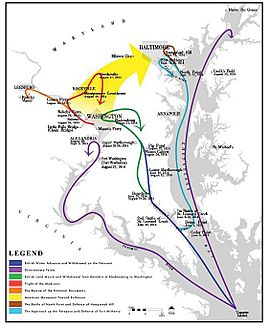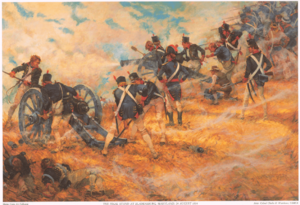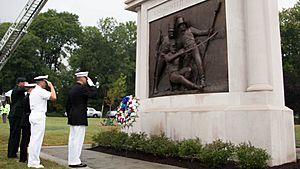Chesapeake Bay Flotilla facts for kids
The Chesapeake Bay Flotilla was a special group of small ships and boats. The United States created it during the War of 1812 to help protect the Chesapeake Bay from British attacks. This period was known as the "Chesapeake Campaign." The Flotilla was led by Joshua Barney, a brave captain.
The Flotilla fought the Royal Navy in several battles that didn't have a clear winner. Eventually, Captain Barney had to sink his own ships on August 22, 1814, so the British couldn't capture them. After losing their ships, the Flotilla's men fought on land to defend Washington, D.C., and Baltimore. The Flotilla was officially ended on February 15, 1815, after the war was over.
| Chesapeake Bay Flotilla | |
|---|---|
Quick facts for kids 
Charles Ball wearing the uniform of the Chesapeake Bay Flotilla.
|
|
| Active | 1813-1815 |
| Country | |
| Allegiance | |
| Branch | |
| Role | artillery |
| Size | 4,370 men (with an additional 700 U.S. marines attached to naval force) |
| Part of | U.S. Department of the Navy |
| Engagements | War of 1812
|
| Commanders | |
| Notable commanders |
Commodore Joshua Barney |
| Chesapeake Campaign | |||||||
|---|---|---|---|---|---|---|---|
| Part of War of 1812 | |||||||
 |
|||||||
|
|||||||
| Belligerents | |||||||
|
|
|||||||
| Commanders and leaders | |||||||
| Joshua Barney | Sir George Cockburn Sir John Warren Alexander Cochrane Robert Ross |
||||||
| Strength | |||||||
|
4,370 sailors Ships: |
Large: 96 Ships: |
||||||
| Casualties and losses | |||||||
|
Artillery Scuttling and burning of Flotilla vessels |
minimal | ||||||
Contents
Building the Flotilla
In July 1813, Captain Joshua Barney suggested a plan to defend the Chesapeake Bay. He told Secretary of the Navy William Jones that small boats and gunboats could fight the British in the Bay's shallow waters. These boats could be sailed or rowed.
In April 1814, Barney set sail with 18 ships. These included:
- Seven barges, 75 feet (23 m) long
- Six barges, 50 feet (15 m) long
- Two gunboats
- One row-galley (a boat moved by oars)
- One lookout boat
- His main ship, the USS Scorpion. This ship was 49 feet (15 m) long and had two large cannons and two smaller cannons called carronades.
The Flotilla's Crews
The men who served in the Flotilla were called "Flotillamen." At its largest, the Flotilla had 4,370 men. These crews were a mix of:
- U.S. Navy sailors
- Merchant sailors (who worked on trading ships)
- Local watermen from the Chesapeake Bay
- Privateers (people who owned armed ships to attack enemy ships)
- Free African Americans
- Enslaved people who sought freedom by joining the British.
Later, when the Flotilla lost its ships and was marching on land, about 700 U.S. Marines joined them. These Marines came from the Washington Navy Yard. They marched north to help defend Washington, D.C., and fought at the Battle of Bladensburg.
Flotilla Operations
Battle of St. Jerome Creek
On June 1, 1814, Barney's Flotilla, led by the Scorpion, was sailing down the Chesapeake Bay. They met a British schooner and boats from two large British warships. The Flotilla chased the British boats until they reached the protection of the bigger ships.
The American Flotilla then went into the Patuxent River. The British quickly blocked the river's entrance. The British had seven times more ships than Barney. This forced the Flotilla to retreat into St. Leonard's Creek on June 7. Three British frigates then blocked the mouth of the creek. The creek was too shallow for the big British warships to enter. Barney's Flotilla had more firepower than the British boats, so they could keep the British from getting in.
Battles continued until June 10. The British were frustrated because they couldn't force Barney out. So, they raided nearby Maryland towns. They attacked and burned Calverton, Huntingtown, Prince Frederick, Benedict, and Lower Marlboro. British units in these raids included Royal Marines and the Corps of Colonial Marines. The Colonial Marines were made up of enslaved African Americans who had joined the British.
Battle of St. Leonard's Creek
On June 26, U.S. Army troops and U.S. Marines arrived to help. Barney then tried to break out of the creek. They launched an attack from both land and sea on the British ships blocking the creek's entrance. This allowed the Flotilla to move out of the creek and further up the river to Benedict, Maryland. However, Barney had to sink two of his gunboats in the creek. The British then entered the empty creek and burned the town of St. Leonard, Maryland.
The British, led by Admiral Sir Alexander Cochrane, moved up the Patuxent River. They were getting ready to land at Benedict, Maryland. For several days, the British fleet fired cannons and congreve rockets at the Flotilla. They wanted to destroy it.
On August 11, 1814, the Flotilla left St. Leonard's Creek and sailed north up the Patuxent River. There was a plan to move the entire Flotilla over land to another river and back to the Bay. But the Secretary of the Navy Jones ordered Barney to take his ships as far up the Patuxent as possible, to Queen Anne. He was told to sink the ships if the British appeared.
On August 22, the British approached the Flotilla. Barney ordered his men to destroy their own ships. He then marched his men and any cannons they could move to Washington, D.C. They were going to join the Battle of Bladensburg.
Battle of Queen Anne
On August 22, the British tried to capture Barney's ships at Queen Anne. The British commander, Admiral Sir George Cockburn, reported what happened. He saw Barney's main ship and the rest of the Flotilla. As his boats got closer, he saw Barney's ship on fire. It soon blew up. He realized that all 17 of Barney's ships were abandoned and on fire, set to explode. Sixteen of them blew up quickly. The seventeenth ship, which didn't catch fire, was captured.
Barney's main ship was a large armed vessel. The others were gunboats, each with a long gun at the front and a carronade at the back. Their guns and crew sizes varied. The British also found 13 merchant ships nearby. Some were burned, and others were taken away. A few Flotilla men fired from the bushes, but they were captured. Some horsemen appeared on the hills, but a few rockets made them leave. The British then took control of the town and the captured ships.

Battle of Bladensburg
On August 24, Barney and the Flotilla fought in the Battle of Bladensburg. The Flotilla stood their ground, and Barney's cannon crews caused many losses for the British. Barney was badly wounded in his leg by a musket ball. Since they were about to be surrounded by British soldiers, he ordered the Flotilla to retreat.
The Flotilla, along with the U.S. Marines from Washington, D.C., were the last American units to leave the battlefield. Records from the Naval Hospital in Washington, D.C., show the names of injured sailors, Marines, and soldiers from the Chesapeake Bay Flotilla after the battle. This helps us know who was hurt at Bladensburg.
Battle of Baltimore
About 500 of the Flotilla men then marched to Baltimore. They joined other forces there and became part of the U.S. Naval Command Second Regiment. They helped defend Baltimore by manning different positions:
| Position | Officer in Command | Men at Position |
|---|---|---|
| Battery Babcock | Sailing Master John Webster | 50 Men |
| Gun Barges | Lt. Solomon Rutter | 338 Men |
| Lazaretto Battery | Lt. Solomon Frazier | 45 Men |
| Ft Mchenry Water Battery | Solomon Rodman | 60 Men |
| Lazaretto Barracks | ------- | 114 Men |
The Flotilla men fought bravely at these positions during the Battle of Baltimore. They caused many losses for the attacking British ships. This was especially true during a night attack on Battery Babcock by British Marines. One Flotilla man, Charles Messenger, was killed, and three others were wounded.
Flotilla Disbanded
After the Battle of Baltimore, the Flotilla did not fight in any more battles. On February 15, 1815, the U.S. Congress ended the law that created the Flotilla. The Chesapeake Bay Flotilla was officially disbanded.
Archeology
In 1978, scientists used a special tool to find the sunken ships of the Flotilla in the upper Patuxent River. They studied the wrecks further in 1979. One ship, called the Turtle Shell Wreck, was found in the main river channel near Wayson's Corner. It was covered by five feet of mud, which helped preserve it well. It looked like the front of the ship was torn off in an explosion.
When the new Route 4 Hills Bridge was built in 1990, parts of Barney's ships were found buried deep under the riverbed.
Today, a copy of one of Joshua Barney's gunboats can be seen at the Bladensburg Waterfront Park.
Honors



